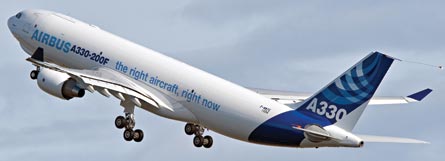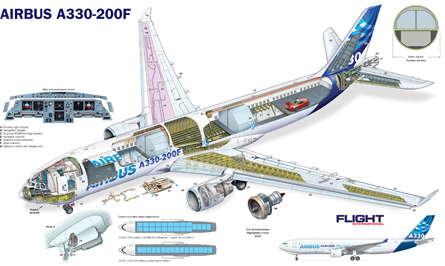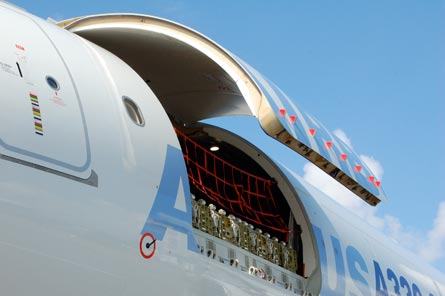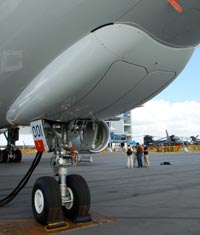When Etihad Crystal Cargo begins earning money with its first A330-200 Freighter this summer, it will mark the culmination of a decade-long development effort for Airbus. The new twinjet is the successor to the A300-600F, a product that sold more than 100 aircraft. The airframer is hoping the A330-200F will be at least as popular.
Although Airbus has sold just 66 A330-200Fs to date, this is just the start, says Airbus freighter marketing manager Jonathan Lesieur. "We see a need for 1,600 midsized freighters over the next 20 years in the 30-80t payload category above the Boeing 757 and below the MD-11, and that's where the A330-200F would play a role. Of these, around 400 will be new-build and the remaining 1,200 through passenger-to-freight 'P2F' conversions," Lesieur says.
|
|---|
TWILIGHT YEARS
As is often the case with all-cargo variants, the -600F propped up the A300's assembly line during its twilight years, enabling production to extend well beyond the demise of demand for the passenger models.
With A300-600F demand remaining buoyant in the early part of the last decade, but its technology starting to look "last century", it was no surprise when Airbus in early 2001 declared it was to develop a cargo version of its then latest twinjet, the fly-by-wire A330-200, to challenge the rival Boeing 767-300F.
Amid talk of a "substantial" order for the new freighter version from an unnamed leasing company, Airbus regarded the A330-200F as a "very low investment" response to the growing demand for a medium-capacity long-range freighter. But amid pressure on engineering and production resources to get the A380 back on track, this became the launch that never was. By 2004 Airbus executives were conceding that the A330-200F was "on the back-burner". By March 2006, it was revived, when then president Noel Forgeard confirmed plans to end A300 production in 2007 and the development of the A330-based freighter to succeed it. In parallel with the -200F, Airbus had also decided to develop a military tanker/transport version of the twinjet.
The A330-200F was finally launched in January 2007, with commitments from Indian cargo start-up Flyington Freighters and lessors Intrepid Aviation Group and Guggenheim Aviation Partners for 32 aircraft. Deliveries were set to begin in late 2009, but during the development programme the schedule has been extended, and last year's cargo market collapse wiped out any pressure on Airbus to rush the new aircraft to market. With Flyington still trying to get off the ground, Etihad Airways' Crystal Cargo arm, which has two A330-200Fs on order, came to the fore and is now set to be launch operator this summer.
The new freighter's DNA can be traced back to the original A330, the 295-seat -300, which was launched into production in June 1987 as the twin-engined sister to the A340 quad, and entered service in January 1994. It became the first Airbus aircraft to be offered with engines from each of the "big three" - namely the General Electric CF6-80E1, Pratt & Whitney PW4000 and Rolls-Royce Trent 700.
|
|---|
Being the spiritual successor to the A300-600F, Airbus has adapted proven concepts from the earlier aircraft for the A330 Freighter, most notably the main-deck cargo door. This is the same size as the door on the A300, and is in the same position in the forward fuselage, says A330/A340 chief engineer Christian Favre. "We've reduced the weight compared with the A300, and optimised the systems."
One change is to the door opening mechanism. On the A300 it had two positions, one of which was almost vertical, but in-service experience has deemed this unnecessary. This was designed to enable bulky items to be craned in to the cargo deck. So the opening angle on the A330 is limited to around 70°, and there has been a simplification of the actuation system, which is electrically controlled and remains hydraulically powered.
|
|---|
The A330 inherits Airbus's original "222in" (5.64m) wide fuselage introduced with the A300B2 series in 1974, giving a maximum internal width of 5.28m. This enables the maindeck cargo deck to accommodate two 96in high by 96in wide industry standard containers side by side.
At 40.8m, the A330-200F's Class E (ie incorporating a smoke/fire detection/protection system) main deck cargo compartment is only slightly longer than that of the A300-600F, with maximum volume quoted as 336m(11,840ft³). To achieve this volume, Airbus quotes a typical maindeck pallet layout as 22 pallets measuring 96 x 125 x 96in, 18 of which are side-by-side with the remaining four one behind the other in the aft part of the cabin. This has a typical design density of 138-149kg/m³ (8.6-9.3lb/ft³). Total cargo volume rises to 475m³ when the lower holds are included. Customers can purchase the main deck's cargo loading system from AAR Cargo Systems, Ancra International, PFW Aerospace or Telair International.
The compartment is split into two temperature zones forward and aft, each capable of maintaining temperatures as low as 5°C (41°F), and as high as 25°C. This low temperature capability, which was verified during the hot weather testing when the A330-200F made an appearance at this year's Singapore air show, is suitable for transporting perishable goods requiring a 5-8°C cabin environment. Cabin temperatures when transporting animals tend to be in the 16-24°C range, says Airbus.
To protect the front of the maindeck compartment, Airbus switched from the 9g cargo net of the A300-600F to a solid aluminium barrier wall positioned in the same location relative to the nose. Favre says that a barrier wall design was chosen over the net as it does not deform, enabling the space available behind the cockpit to be used more effectively.
This area is occupied by a courier cabin, from which it is possible to access the cargo compartment through hatches in the barrier wall on each side. The courier area is fully customisable, with features including up to 12 passenger seats, folding flight-attendant seats, a galley, lavatory and flightcrew rest compartment with two bunks. It also includes provisions for a loadmaster workstation.
One significant visual change for the A330-200F is the blister faring under the nose that accommodates the revised landing gear arrangement. Nicknamed "La boufiolle" by Airbus's French engineers (referring to the bulbous shape of a chemist's apothecary jar), the fairing is an elegant solution to a problem that took many years to resolve - that is the A330/A340 family's nose-down body angle of around 1.5° when on the ground.
While this is not an issue in the passenger role, it threatened to be a headache for cargo loaders moving pallets around on the cargo deck. "The ultimate objective was to offer an aircraft that was easy to load without requiring power drive units to move pallets around which have maintenance, weight and cost issues," says Favre.
"For this we had to have an attitude on the ground as close as possible to 0°, and we wanted it to be a little bit better than the A300, which we knew was acceptable. So we've achieved a slope of roughly 0.5/0.6° down."
Favre says that there was a long internal evaluation of possible solutions to the nose-down issue, with the first studies beginning in around 2000, but the final decision - to lower the nosegear leg attachment and the bay - was not taken until 2006.
"There were 13 different options studied, from reasonable ones to unreasonable ones," says Favre.
Criteria such as commonality, "retrofitability", reliability, weight and cost were all considered. The alternatives that were eventually discarded are as follows:
- Shortening the nose gear leg.
- Integral jacking system.
- Hydraulic extension.
- Lengthened gear and bay.
- A340-600 nose gear.
- A350 nose gear.
- Bottle jack.
- Aircraft jack.
- Ramp.
- High-lift towbar-less tractor.
- Main deck cargo loading system and power drive units.
- Multiple minor changes.
Eventually the choices were boiled down to "two reasonable ones - change the gear and keep the gear bay, or change the gear bay and keep the gear", says Favre. The former, which centred on a shortening gear-leg incorporating a compressing oleo, was initially favoured, but ultimately the latter was adopted because "for the customer it is fly and forget - with common gear to the passenger model".
So Airbus has simply lowered where the nose-gear leg's articulation link attaches by 370mm (14.5in). This gives the required deck angle on the ground, but puts the gear outside the fuselage loft line, Farvre says. "Therefore we had to design a fairing, which we could show by CFD [computational fluid dynamics] analysis had almost zero drag impact. And this has been confirmed in flight-testing - there is no buffet or noise and the high-speed performance is beyond expectations."
From a performance and payload perspective, the A330-200F is in a different league to its predecessor, being able to carry around 15t more payload than the A300-600F a further 2,500km (1,350nm). This means it can haul a maximum payload of 70t over 5,930km, or in "range mode" fly 65t over a maximum distance of 7,400km.
UPGRADES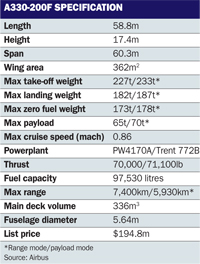 Structurally the A330-200F benefits from all the weight growth of the passenger variants, and its development has fed back further upgrades to its sister models, says Favre.
Structurally the A330-200F benefits from all the weight growth of the passenger variants, and its development has fed back further upgrades to its sister models, says Favre.
"The A330-200 passenger variant was initially operated with a maximum take-off weight of 215t, and 230t was available in 1998. In 2000 we introduced what we called the 'growth' with 233t MTOW," he says.
The "growth" was the first of two structural developments on the aircraft, the second of which being central to the enhanced variant introduced in 2003, but not incorporating any further weight increases.
"The enhanced had important changes to the fuselage and wing - material changes and weight reduction. It was a re-optimisation of the aircraft with the main objective to increase the design service goal," says Favre. "Improvements included an enhanced landing gear with design improvements."
The freighter has the 233t MTOW of current A330-200s, while MZFW is up to 8t above the passenger variant, at 178t. But the passenger model is about to gain further weight growth and performance, thanks to the freighter. "When we were developing the freighter, we had a close look at the wing in particular, which was the limiting element, and could find the margins to demonstrate the passenger aircraft could be capable of 235t MTOW, or 238t with a 2t reduction maximum zero fuel weight [to 168t]."
This upgrade, which is introduced this year on new-build aircraft providing up to an additional 650km range, will be available as a retrofit to the in-service A330s built to enhanced standard (that is, from MSN555) with a small package of modifications.
"There are some material changes in some areas on the fuselage around the centre section and some new fasteners," says Favre, with no wing modifications are needed for the majority of eligible aircraft. Meanwhile, further weight and range growth "is being studied" for the freighter, he adds.
Given its all-freight role, the A330-200F is devoid of passenger windows (bar a couple for courier zone occupants and for visual inspections) and has just the passenger variant's two forward (L1/L2) cabin doors. Beneath the skin, Favre says Airbus has optimised the aircraft's structure for its cargo role. "The A330-200F was designed as a freighter - that is to say we redesigned some of the sections - in particular the mid-wing areas and the forward fuselage section 13/14 where the cargo door is installed," he says.
OPTIMUM STRUCTURE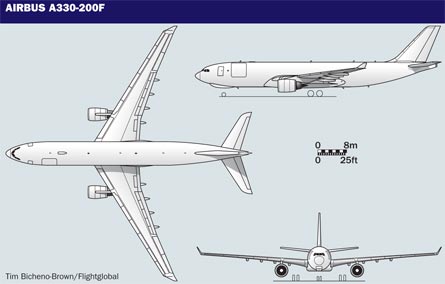
Several considerations were taken into account to optimise the structure for the freighting role says Favre. "Firstly, a freighter has a more forward CG [centre of gravity] than on a passenger aircraft so there is an impact on the loads that we have to take into account.
"Secondly, we have specific loads to accommodate that required the floor and adjacent areas to reinforced.
"Thirdly, we want to offer flexibility to cargo loading and allow maximum freedom for cargo along the fuselage, so we sized the aircraft accordingly. A sheer and bending curve was determined to develop a load envelope with the highest probability of success in enabling any combination of pallet loading."
Favre says that the A330-200F is able to have a significantly more forward CG than the passenger version: "The maximum forward CG certificated on the freighter is 16%, compared with 18% on the passenger variant."
At the time Airbus was developing the freighter it launched a weight-saving campaign across all the variants. Favre says that as well as simply to save weight, the exercise was designed to "more than offset" the weight gains associated with additional materials and systems required for compliance with future safety regulations regarding flammability standards for insulation and centre fuel-tank inerting.
The A330-200's centre tank is deactivated on the -200F to save the weight of the inerting system, reducing fuel capacity by 41,560 litres. However it is offered as an option.
Modifications included material changes, such as a switch to that used on the A380 for some air conditioning bleed pipes, says Favre. Overall, the "diet" shaved off between 200kg and 250kg on the passenger aircraft, depending on whether it is a -200 or -300.
A specific weight-reduction campaign was also applied to the A330-200F from the start, related to freighter-specific items, says Favre. "We had three specific efforts -weight reduction common with the passenger variants; savings specific to the -200F compared with A300-600F and our initial estimations; and the use of all available margins that we had on the fuselage and the wing."
One example of how weight was saved was the switch from glassfibre to carbonfibre for the floor panel material. Overall, the A330-200F incorporates some 9t of advanced materials (carbonfibre, glassfibre and quartzfibre reinforced plastic), which are used in areas such as the flaps, the fin and tailplane, the belly faring, gear doors, radome and engine cowlings.
The success of the programme allowed Airbus to announce at the time of the first flight that the -200F's empty weight had turned out to be 1t less than originally forecast. This improvement went straight to the bottom line, boosting the maximum payload from the 69t originally forecast to 70t.
"We have already weighed one aircraft and we are well within this," says Favre. "Once we have weighed three we will be perfectly sure to confirm this to the customers and incorporate it in the offers."
The A330-200F is offered with the latest PW4000 and Trent 700 engine options from P&W and R-R, respectively. GE is not on the -200F programme as it could not make a strong enough business case. Airbus quotes thrust ratings in the 68,000-71,100lb (303-317kN) range, and specifically the PW4170A at 70,000lb and Trent 772B at 71,100lb. Both engines have been subject to enhancement packages introduced last year, dubbed the Advantage 70 and 700EP, respectively.
The PW4000-powered version became the lead powerplant for certification, a legacy of the engine's selection by original launch customer Flyington Freighters. The flight-test programme began on 5 November 2009 with the first flight of the PW4000-powered MSN1004. A second aircraft, the Trent 700-powered MSN1032, joined the programme on 20 January, although 1004 flew the bulk of the roughly 200h in the test and certification programme. European approval was granted on 9 April.MSN1032 will be the first delivered this summer to launch operator Etihad Airways. The five deliveries due this year include the first of three for lessor Aircastle placed with China's Hainan Airlines. The first test aircraft, for Turkish Airlines, is being re-engined with Trents.
A330-200F SALES FORTUNES ENDURE BUMPY RIDE
ALTHOUGH Airbus's A330-200F salesmen got off to a strong start, the recent downturn in the cargo market stymied bookings. This, allied to the surge in demand for passenger A330s in the wake of the 787 delays, has caused the -200F's orderbook to decline slightly, and it now stands at 66 aircraft from 11 customers. The freighter's sales tally represents only a small proportion of total A330 sales, which stand at 1,015 aircraft, of which 688 have been delivered (379 -200s and 309 -300s).
Airbus needs to quickly take advantage of the current rebound in the cargo market to build the orderbook with some blue-chip cargo airlines. Two-thirds of the current orders (44) are from lessors, while there are doubts over the biggest airliner customer, Indian start-up Flyington Freighters, which has yet to launch.
The A330-200F's range, payload and cargo volume pitches it primarily at the general cargo market, as a rival to the lower-payload, shorter-range Boeing 767-300F and it is positioned to replace the ageing fleet of McDonnell Douglas DC-10Fs.
"For the first time, with the A330-200F there is a competitor in the midsize payload category that has range equivalent to the larger long-haul freighters, but offering better unit costs," says Airbus's freighter marketing manager Jonathan Lesieur. He believes that the current environment of rising fuel cost and low yields will attract customers to the A330 from the fuel-thirsty DC-10 trijets.
But if Airbus is going to tap the potentially huge market for the replacement of package freighters operated by integrators such as FedEx Express, which is driven by high volume rather than cargo density, it will need a freighter version of the larger A330-300. This is most likely to come through the conversion of ex-airline -300s, says Lesieur, so the needs of a future passenger-to-freighter (P2F) modification programme were considered during the development of the -200 production freighter. "A lot of the -200F engineering would apply to a -300P2F," he says. "It would have 20% more volume than the A330-200F, but around 8-10t lower payload, which means its design density is more for express carriers."
Didier Lenormand, Airbus freighter marketing chief, explains the A330-200F's key features. Watch here:
Source: Flight International





















